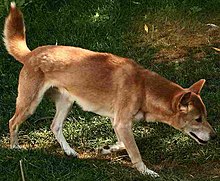New Guinea singing dog
| New Guinea singing dog | |
|---|---|
 |
|
| Scientific classification | |
| Kingdom: | Animalia |
| Phylum: | Chordata |
| Class: | Mammalia |
| Order: | Carnivora |
| Family: | Canidae |
| Genus: | Canis |
| Species: | C. lupus |
| Subspecies: | C. l. dingo |
| Trinomial name | |
|
Canis lupus dingo |
|
| Synonyms | |
|
Canis hallstromi (Troughton, 1957) |
|
Canis hallstromi (Troughton, 1957)
The New Guinea singing dog (Canis lupus dingo) is named for its unique vocalization. Some experts have referred to it as a wild dog but others disagree. Little is known about New Guinea singing dogs in the wild and there are only two confirmed photographs of wild sightings. Captive-bred New Guinea Singing Dogs serve as companion dogs.
The New Guinea Singing Dog, also known as Hallstrom’s dog, is named for its distinctive and melodious howl, which is characterized by a sharp increase in pitch at the start and very high frequencies at the end.
In 2016, a literature review found that: "there is no convincing evidence that New Guinea wildliving dogs and some, or all, pre-colonization New Guinea village dogs were distinct forms. Further, there is no definitive evidence that either high altitude wild-living dogs were formerly isolated from other New Guinea canids or that the animals that were the founding members of captive populations of New Guinea Singing Dogs were wild-living animals or the progeny of wild-living animals rather than being born and raised as members of village populations of domestic dogs. We conclude that: (1) at the time of European colonization, wild dogs and most, if not all, village dogs of New Guinea comprised a single though heterogeneous gene pool (2) eventual resolution of the phylogenetic relationships of New Guinea wild dogs will apply equally to all or most of the earliest New Guinea village-based, domesticated, dogs; and (3) there remain places in New Guinea, such as Suabi and neighbouring communities, where the local village-based population of domestic dogs continues to be dominated by individuals whose genetic inheritance can be traced to pre-colonization canid forebears."
In 1897, Charles Walter De Vis collected the first specimen from Mount Scratchley at about 2,400 m elevation and described it. In 1956, Albert Speer and J.P. Sinclair obtained a pair of singing dogs in the Lavani Valley and situated in Southern Highlands Province, Papua New Guinea. The dogs were sent to Sir Edward Hallstrom who had set up a native animal study center in Nondugi, and then on to the Taronga Zoo in Sydney, Australia. In 1958, Ellis Troughton examined the two singer specimens from the Taronga Zoo in Sydney. Subsequently, the New Guinea singing dog was classified as a distinct species and was named Canis hallstromi (in honour of Sir Edward Hallstrom). In 2005 it was classified under Canis lupus dingo in Mammal Species of the World.
...
Wikipedia

